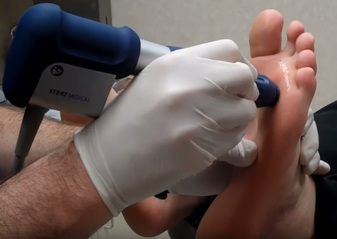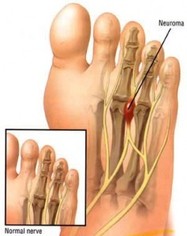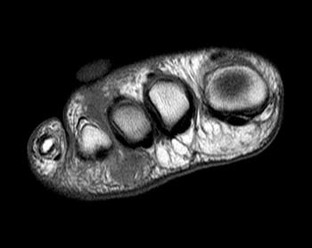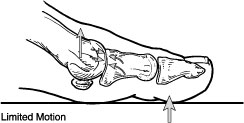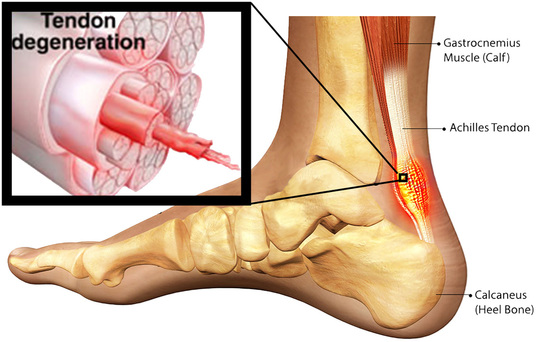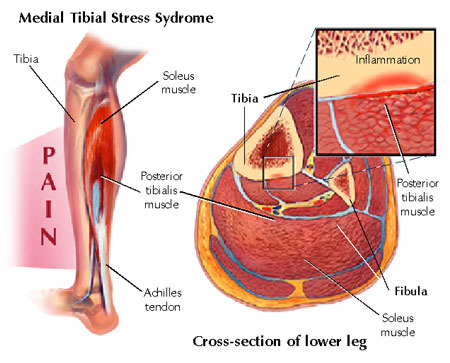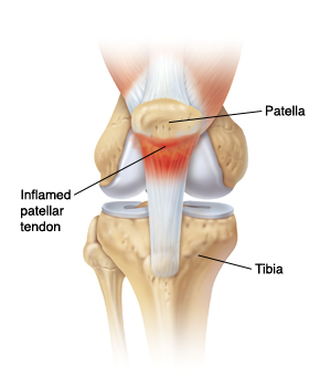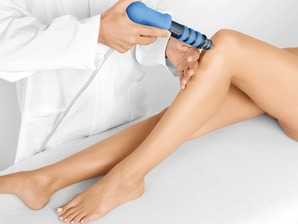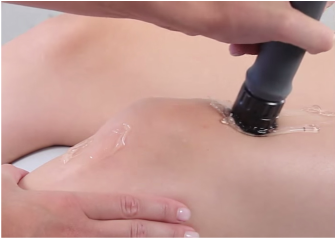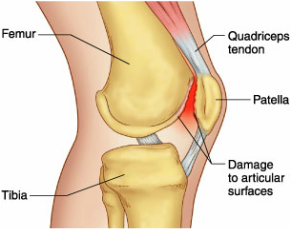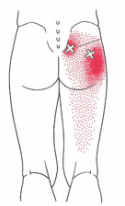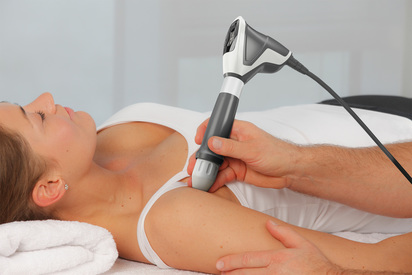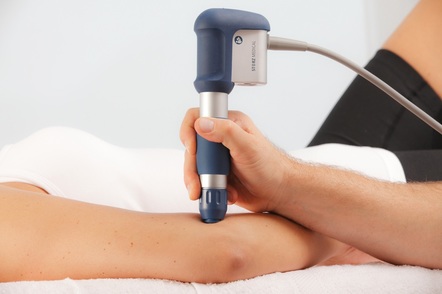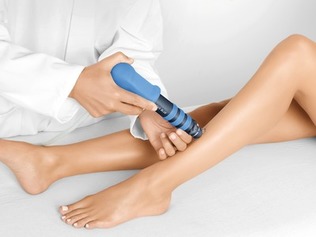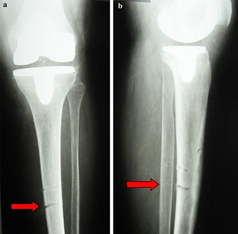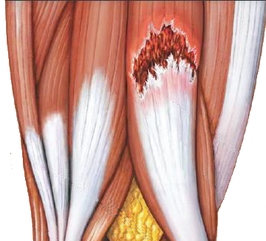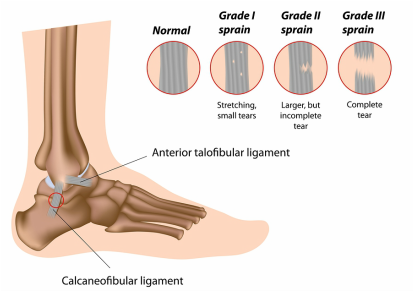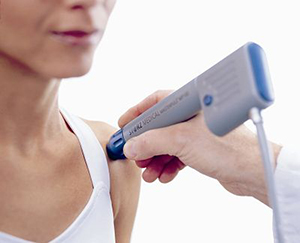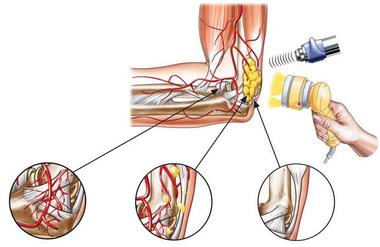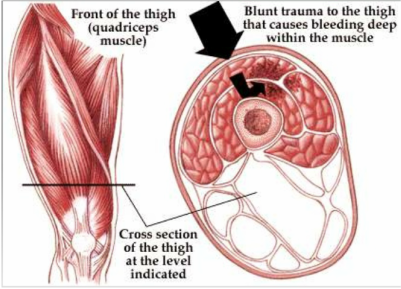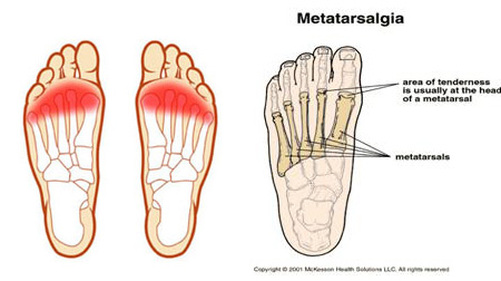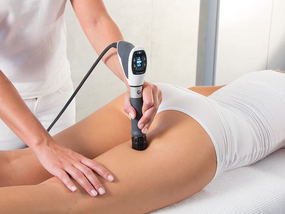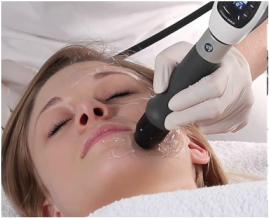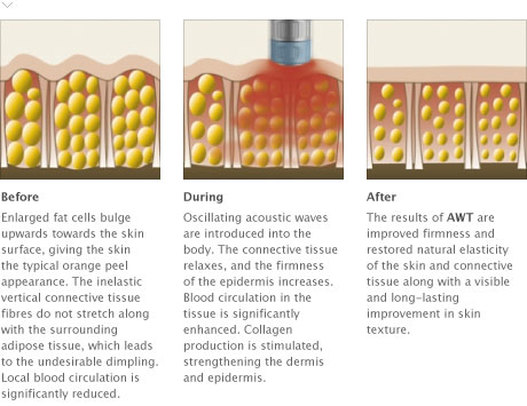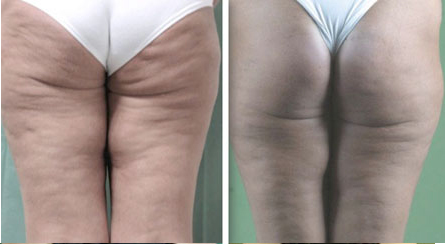The plantar fascia is a thick, fibrous band of connective tissue. Its origin is the inside under surface of the heel. It runs along the sole of the foot like a fan, being attached at its other end to the base of each of the toes. It is a tough, resilient structure that has a number of critical functions during running and walking.
Symptoms of plantar fasciitis:
When this band becomes inflamed, the heel and bottom of the foot become extremely painful and sensitive. As the fascia worsens, the pain becomes even more intense, and may even persist while resting. If not treated, the formation of bone (calcifications) within the plantar fascia band may develop. These are commonly referred to as heel spurs, and without intervention therapy such as shockwave, a very long rehabilitation period is expected.
At Granville Physio your therapist will not only be able to provide you with exercises, insoles, and education that help prevent this from happening again but also provide the treatment that is proven to most effectively cure this problem (91% of the time shockwave cures plantar fasciitis! Foot & Ankle International, 2012).
Symptoms of plantar fasciitis:
- Pain on the bottom of the heel
- Pain in the arch of the foot
- Pain that is usually worse upon arising
- Pain that increases over a period of months
When this band becomes inflamed, the heel and bottom of the foot become extremely painful and sensitive. As the fascia worsens, the pain becomes even more intense, and may even persist while resting. If not treated, the formation of bone (calcifications) within the plantar fascia band may develop. These are commonly referred to as heel spurs, and without intervention therapy such as shockwave, a very long rehabilitation period is expected.
At Granville Physio your therapist will not only be able to provide you with exercises, insoles, and education that help prevent this from happening again but also provide the treatment that is proven to most effectively cure this problem (91% of the time shockwave cures plantar fasciitis! Foot & Ankle International, 2012).
Morton’s Neuroma
A neuroma is a thickening of nerve tissue that may develop in various parts of the body. The most common neuroma in the foot is a Morton’s neuroma, which typically occurs between the third and fourth toes. Often described as a feeling of "walking on a marble", it is a result of inflammation and thickening of the nerve located between the bones of the toes. The damaged nerve results in sharp, burning pain in the ball of the foot, and can also cause numbness or stinging in the toes.
At Granville Physio your therapist will teach you how to improve your arch mechanics, successfully apply a supportive device such as tape and insoles, and use the best equipment to reduce the size of the neuroma through shockwave, ultrasound, and ice.
In a 2009 study in the Journal of the American Podiatric Medical Association, patient's with chronically irritated Morton's neuromas, who had received 8 months (41.6 months was the mean) of conservative treatment, were put into two groups where both received intravenous sedation. In the group that received one shockwave treatment 82% had a 50% improvement in pain on follow up vs 21% in the sham group. The average improvement in the shockwave group was 65% and in the sham group 25%. Remember, this is after only one treatment in individuals that had been in 7.2/10 pain for an average of 41.6 months!
At Granville Physio your therapist will teach you how to improve your arch mechanics, successfully apply a supportive device such as tape and insoles, and use the best equipment to reduce the size of the neuroma through shockwave, ultrasound, and ice.
In a 2009 study in the Journal of the American Podiatric Medical Association, patient's with chronically irritated Morton's neuromas, who had received 8 months (41.6 months was the mean) of conservative treatment, were put into two groups where both received intravenous sedation. In the group that received one shockwave treatment 82% had a 50% improvement in pain on follow up vs 21% in the sham group. The average improvement in the shockwave group was 65% and in the sham group 25%. Remember, this is after only one treatment in individuals that had been in 7.2/10 pain for an average of 41.6 months!
Hallux Rigidus
Hallux rigidus is a disorder of the joint located at the base of the big toe. It causes pain and stiffness in the joint, and with time it gets increasingly harder to bend the toe. ‘Hallux” refers to the big toe, while “rigidus” indicates that the toe is rigid and cannot move. Hallux rigidus is a form of degenerative arthritis.
Because hallux rigidus is a progressive condition, the toe’s motion decreases as time goes on. In its earlier stage, when motion of the big toe is only somewhat limited, the condition is called “hallux limitus.” But as the problem advances, the toe’s range of motion gradually decreases until it potentially reaches the end stage of “rigidus,” in which the big toe becomes stiff, or what is sometimes called a “frozen joint.”
Common causes of hallux rigidus are faulty function (biomechanics), structural abnormalities of the foot, and genetics.
At Granville Physio your therapist will teach you how to improve your arch mechanics, successfully apply a supportive device such as tape and insoles, and use the best equipment to reduce the size of the rigid deformity through shockwave, ultrasound, and ice.
Because hallux rigidus is a progressive condition, the toe’s motion decreases as time goes on. In its earlier stage, when motion of the big toe is only somewhat limited, the condition is called “hallux limitus.” But as the problem advances, the toe’s range of motion gradually decreases until it potentially reaches the end stage of “rigidus,” in which the big toe becomes stiff, or what is sometimes called a “frozen joint.”
Common causes of hallux rigidus are faulty function (biomechanics), structural abnormalities of the foot, and genetics.
At Granville Physio your therapist will teach you how to improve your arch mechanics, successfully apply a supportive device such as tape and insoles, and use the best equipment to reduce the size of the rigid deformity through shockwave, ultrasound, and ice.
Achilles Tendonitis (Tendinopathy)
The Achilles tendon is the largest tendon in the body. It connects the calf muscles at the back of your leg to your heel bone. Achilles tendinopathy occurs when this tendon becomes inflamed. Usually the result of overuse, poor foot mechanics, excessively tight calf/foot muscles or a combination of all three.
In order to alleviate achilles tendonitis pain, the swelling must be reduced. Without proper treatment, this condition can lead to much more serious injuries, such as achilles tendinosis and tearing of the tendon.
At Granville Physio your therapist will teach you how to improve your arch mechanics, eccentrically strengthen your calf, successfully apply a supportive device such as tape and insoles, and use the best equipment to release the muscles of your calf and promote healing in the achilles tendon using shockwave, ultrasound, ice, and other treatment modalities. Shockwave on it's own has been shown to cure 76% of achilles tendon injuries.
In order to alleviate achilles tendonitis pain, the swelling must be reduced. Without proper treatment, this condition can lead to much more serious injuries, such as achilles tendinosis and tearing of the tendon.
At Granville Physio your therapist will teach you how to improve your arch mechanics, eccentrically strengthen your calf, successfully apply a supportive device such as tape and insoles, and use the best equipment to release the muscles of your calf and promote healing in the achilles tendon using shockwave, ultrasound, ice, and other treatment modalities. Shockwave on it's own has been shown to cure 76% of achilles tendon injuries.
Shin Splints
Shin splints refers to the pain experienced along front outer surface (lateral tibial stress syndrome) or inner section (medial tibial stress syndrome) of the lower leg. This pain is usually the result of inflammation of the muscles, tendons, and bone. Shin splints usually develop during or after physical activity, and the pain can be either sharp and knife-like or dull and throbbing. While this condition can be left to heal without intervention, recovery requires the individual to stop all forms of physical activity that may be aggravating the shin areas, and can take quite a while to fully disappear.
At Granville Physio your therapist will teach you how to improve your arch mechanics, appropriately release and stretch the region, and successfully apply a supportive device such as tape and insoles to the area. Additionally, the best equipment will be used to release the muscles of your calf and foot to promote healing in the shin and surrounding muscles using shockwave, ultrasound, and ice.
In a 2012 study in the British journal of Sports Medicine, they found that the duration to return to sport from shin splints was 59.7 (SD 25.8) days in the group that had a running program and shockwave while the group with the running program only required 91.6 (SD 43.0) days to return to sport. The shockwave group returned to sport 35% faster!
In a 2010 study in the American Journal of Sports Medicine, they found that 85.1% of the athletes treated with shockwave had returned to their preinjury sport following 3 shockwave treatments while only 46.8% of the non shockwave group were able to return to sport.
At Granville Physio your therapist will teach you how to improve your arch mechanics, appropriately release and stretch the region, and successfully apply a supportive device such as tape and insoles to the area. Additionally, the best equipment will be used to release the muscles of your calf and foot to promote healing in the shin and surrounding muscles using shockwave, ultrasound, and ice.
In a 2012 study in the British journal of Sports Medicine, they found that the duration to return to sport from shin splints was 59.7 (SD 25.8) days in the group that had a running program and shockwave while the group with the running program only required 91.6 (SD 43.0) days to return to sport. The shockwave group returned to sport 35% faster!
In a 2010 study in the American Journal of Sports Medicine, they found that 85.1% of the athletes treated with shockwave had returned to their preinjury sport following 3 shockwave treatments while only 46.8% of the non shockwave group were able to return to sport.
Jumper's Knee (Patellar Tendinopathy)
The patellar tendon is a short, wide band that connects the patella (kneecap) to the tibia (shinbone). A large amount of stress is placed on the patellar tendon during jumping or running activities, and this stress can lead to micro-damage and degeneration over time. If not properly treated it can result in a torn or ruptured patellar tendon.
A 2007 study in the American Journal of Sports Medicine followed up with patients 2 to 3 years after they had shockwave treatment or conservative treatment. The shockwave group reported the following breakdown of their current state: 43% excellent, 47% good, 10% fair, and none poor. In the conservative treatment group 0% excellent, 50% good, 25% fair, and 25% poor. Recurrence of symptoms occurred in 13% of the shockwave group and 50% of the conservative treatment group.
At Granville Physio your therapist can effectively use both methods for an even better outcome! They can use shockwave and teach you how to improve your arch mechanics, appropriately release and stretch the muscles of the thigh, strengthen the pelvis to obtain stability and reduce reliance on the quadriceps muscles, and potentially apply a supportive device such as a patellavator to the tendon and insoles to the feet.
A 2007 study in the American Journal of Sports Medicine followed up with patients 2 to 3 years after they had shockwave treatment or conservative treatment. The shockwave group reported the following breakdown of their current state: 43% excellent, 47% good, 10% fair, and none poor. In the conservative treatment group 0% excellent, 50% good, 25% fair, and 25% poor. Recurrence of symptoms occurred in 13% of the shockwave group and 50% of the conservative treatment group.
At Granville Physio your therapist can effectively use both methods for an even better outcome! They can use shockwave and teach you how to improve your arch mechanics, appropriately release and stretch the muscles of the thigh, strengthen the pelvis to obtain stability and reduce reliance on the quadriceps muscles, and potentially apply a supportive device such as a patellavator to the tendon and insoles to the feet.
Most commonly occurring in young children and adolescents, Osgood Schlatter disease is an irritation of the outer bone covering (the periosteum) at the tibial tuberosity which results in excess bone growth due to growth spurts combined with tight muscles and excessive use. It is characterized by a large, tender bump that develops underneath the kneecap, and can result in pain during exercise or with contact. If not properly treated, this condition can cause lasting damage to growth plates.
With conservative treatment only, the pain can take as long as 2-3 years to fully dissipate. However, at Granville Physio, your therapist can use Shockwave therapy to help accelerate the healing process and get you back to normal, pain-free activity sooner! The International Journal of Advanced Research in Biological Sciences published a study in 2014 highlighting the effectiveness of Shockwave therapy for the treatment of Osgood Schlatter disease. The study found significant improvements in severity of knee pain and mobility of the knee with Shockwave therapy, compared to stretching and IFC treatment alone!
With conservative treatment only, the pain can take as long as 2-3 years to fully dissipate. However, at Granville Physio, your therapist can use Shockwave therapy to help accelerate the healing process and get you back to normal, pain-free activity sooner! The International Journal of Advanced Research in Biological Sciences published a study in 2014 highlighting the effectiveness of Shockwave therapy for the treatment of Osgood Schlatter disease. The study found significant improvements in severity of knee pain and mobility of the knee with Shockwave therapy, compared to stretching and IFC treatment alone!
Iliotibial Band (ITB) Syndrome
The iliotibial (IT) band is the large band of fascia that runs down the lateral (outer) edge of the thigh. It connects from the hip to the knee, and is extremely important in the stabilization and movement of the knee joint. Iliotibial band syndrome (ITBS) is a common overuse injury, and often manifests in runners, hikers, and cyclists.
Rather than friction causing irritation of the ITB, it is now thought that compression of the associated fat layer (seen in the middle picture) is the main culprit. This fat is full of small blood vessels and nerves (Pacinian corpuscles) which makes it a far more likely suspect as the pain generating structure in ITB syndrome. The reasons for excessive compression are excessive tightness of the outside quadraceps (usually from weak pelvic stability), tightness of the tensor fascia latte, and tightness of the gluteus maximus.
Most commonly, the symptoms of ITBS are swelling and pain on the outside, upper edge of the knee. This is especially notable when walking down stairs or running downhill. If left untreated, the condition can become chronic. Traditionally, prescribed treatment is ice, elevation, and unfortunately, an extended rest from the aggravating activities.
At Granville Physio, your therapist can use shockwave therapy to target the IT band and associated tight muscles, accelerating the healing of the irritated fascia and fat pad. Additionally, we can teach you how to improve your arch mechanics, appropriately release and stretch the muscles of the thigh, strengthen the pelvis to obtain stability and reduce reliance on the quadriceps muscles, and potentially apply insoles to the feet.
Rather than friction causing irritation of the ITB, it is now thought that compression of the associated fat layer (seen in the middle picture) is the main culprit. This fat is full of small blood vessels and nerves (Pacinian corpuscles) which makes it a far more likely suspect as the pain generating structure in ITB syndrome. The reasons for excessive compression are excessive tightness of the outside quadraceps (usually from weak pelvic stability), tightness of the tensor fascia latte, and tightness of the gluteus maximus.
Most commonly, the symptoms of ITBS are swelling and pain on the outside, upper edge of the knee. This is especially notable when walking down stairs or running downhill. If left untreated, the condition can become chronic. Traditionally, prescribed treatment is ice, elevation, and unfortunately, an extended rest from the aggravating activities.
At Granville Physio, your therapist can use shockwave therapy to target the IT band and associated tight muscles, accelerating the healing of the irritated fascia and fat pad. Additionally, we can teach you how to improve your arch mechanics, appropriately release and stretch the muscles of the thigh, strengthen the pelvis to obtain stability and reduce reliance on the quadriceps muscles, and potentially apply insoles to the feet.
Patella Femoral Stress Syndrome (chondromalacia patella)
Patella tracking pain occurs when the patella (knee cap) does not move in its proper position. The patella has an optimal range of function, gliding over a groove in the femur (thighbone). When imbalances in the knee joint occur, from factors such as asymmetrically tight muscles or inflamed ligaments, the patella can be pulled off of this tracking. As seen in the diagrams above, abnormal tracking results in a redistribution of the compressive forces experienced within the knee joint, causing arthritic changes to the thin layer of articular cartilage on both the under surface of the patella and the femoral condyle.
Symptoms include:
At Granville Physio, your therapist can use shockwave therapy to target the outside thigh and associated tight muscles accelerating the lengthening of the outside quadriceps muscles and fascial tissue. Additionally, we can teach you how to improve your arch mechanics, appropriately release and stretch the muscles of the thigh, strengthen the pelvis to obtain stability and reduce reliance on the quadriceps muscles, and potentially apply insoles to the feet.
Symptoms include:
- burning pain in the front of the knee, especially when squatting, jumping, kneeling
- the sensation that the knee is buckling, or cannot support weight
- catching, clicking, grinding, or popping in the kneecap when the joint is manipulated
- pain when sitting or having the knee joint in a bent position
At Granville Physio, your therapist can use shockwave therapy to target the outside thigh and associated tight muscles accelerating the lengthening of the outside quadriceps muscles and fascial tissue. Additionally, we can teach you how to improve your arch mechanics, appropriately release and stretch the muscles of the thigh, strengthen the pelvis to obtain stability and reduce reliance on the quadriceps muscles, and potentially apply insoles to the feet.
Bursitis
A bursa is a small, synovial fluid-filled sac. There are more than 150 bursae throughout the body, and they provide a cushioning between the bones and tendons/muscles surrounding our joints. Healthy bursae provide lubrication to joints, allowing for smooth gliding and painless movement.
Bursitis is the inflammation of these bursae, due to irritation or infection. When the bursae become inflamed, they swell with fluid and put pressure on the joints. This results in painful or restricted movement of the joint, as well as muscle stiffness. Shockwave therapy has been shown to be an effective treatment option for bursitis, as an alternative to corticosteroid injections or in conjunction with home training strategies.
In a systematic review by the British Medical Bulletin, it was found that 4 months after treatment began, 34% of home training patients, 49% of corticosteroid patients, and 64% of shockwave patients had returned to previous levels of activity. Furthermore, 15 months after treatment began, these numbers had improved to 74-80% for shockwave and home therapy, a drastic improvement on corticosteroid injection patients at only 48%. Shockwave therapy is becoming an increasingly attractive long-term recovery option for bursitis pain.
Bursitis is the inflammation of these bursae, due to irritation or infection. When the bursae become inflamed, they swell with fluid and put pressure on the joints. This results in painful or restricted movement of the joint, as well as muscle stiffness. Shockwave therapy has been shown to be an effective treatment option for bursitis, as an alternative to corticosteroid injections or in conjunction with home training strategies.
In a systematic review by the British Medical Bulletin, it was found that 4 months after treatment began, 34% of home training patients, 49% of corticosteroid patients, and 64% of shockwave patients had returned to previous levels of activity. Furthermore, 15 months after treatment began, these numbers had improved to 74-80% for shockwave and home therapy, a drastic improvement on corticosteroid injection patients at only 48%. Shockwave therapy is becoming an increasingly attractive long-term recovery option for bursitis pain.
Piriformis Syndrome
The piriformis is a flat muscle located in the buttocks, near the top of the hip. It is important for rotating the legs away from the body (abduction), stabilizing the hips, and keeping balanced. The sciatic nerve is the largest and longest nerve in the human body, starting in the lower back, travelling through the buttocks, and running down the lower leg. This nerve passes in under the piriformis muscle, and in some individuals fibers of the nerve may even pass directly through the piriformis!
When the piriformis muscle is very tight, it may compress the sciatic nerve. This results in tingling, numbness, pain, and tenderness in the buttocks and radiating down the leg. This pain can be triggered from running, sitting for extended periods, or any activity that may activate the piriformis muscle. The pain can be quite debilitating, with some individuals reporting an inability to sleep or find a comfortable stance. Often times there are issues in both the low back and in the piriformis and this can lead to compression of the nerve in more than one location.
Additionally, trigger points (small knots in muscles that send or “refer” pain to other areas of the body) can cause symptoms similar to that of sciatica or piriformis syndrome.
Thankfully all our therapists at Granville Physio will be able to find the true cause of your pain. Your therapist will be able to use shockwave therapy and tailored exercises to relieve the compression on the sciatic nerve, which means no more pain! In fact, studies have shown that in some cases, a complete absence of pain and symptoms are reported after only four sessions!
When the piriformis muscle is very tight, it may compress the sciatic nerve. This results in tingling, numbness, pain, and tenderness in the buttocks and radiating down the leg. This pain can be triggered from running, sitting for extended periods, or any activity that may activate the piriformis muscle. The pain can be quite debilitating, with some individuals reporting an inability to sleep or find a comfortable stance. Often times there are issues in both the low back and in the piriformis and this can lead to compression of the nerve in more than one location.
Additionally, trigger points (small knots in muscles that send or “refer” pain to other areas of the body) can cause symptoms similar to that of sciatica or piriformis syndrome.
Thankfully all our therapists at Granville Physio will be able to find the true cause of your pain. Your therapist will be able to use shockwave therapy and tailored exercises to relieve the compression on the sciatic nerve, which means no more pain! In fact, studies have shown that in some cases, a complete absence of pain and symptoms are reported after only four sessions!
Dupuytren's Contracture
Dupuytren's contracture is a specific type of fibromatosis, which simply means an overgrowth of connective tissue. Underneath the skin and subcutaneous tissue layers of the hand is a complex connective tissue layer, consisting of tendons and membranes such as the palmar aponeurosis. In fibromatosis, connective tissue thickens, shortens and develops small fibromas. When this happens in the palmar aponeurosis of the hand, it is referred to as Dupuytren's contracture.
An obvious symptom of this condition is the curling of the pinky and ring fingers downward. In severe cases, the middle finger may also curl down slightly. This is a result of the shortened tendons connecting to the fingers, and as the condition progresses the fingers are no longer able to fully straighten. Finger joints may become fixed and rigid, and often patients report pain, itching and aching sensations. Dupuytren's contracture gets progressively worse with time, and has been shown to have a high recurrence rate with traditional treatment options.
Shockwave therapy is an alternative, non-invasive treatment option that is yielding exciting results in many fibromatosis cases. At Granville Physio, your therapist will apply the shockwave head to the affected palmar area, helping to decrease the force of the contraction, and breaking down the fibromas over time. Using a pain scale of 1-10, it was found in one study that patients receiving treatment for severe fibromatosis showed a decrease from pain level 6 to pain level 1! In all patients, a softening of the fibromas was also reported. This was after only 1-3 treatments!
An obvious symptom of this condition is the curling of the pinky and ring fingers downward. In severe cases, the middle finger may also curl down slightly. This is a result of the shortened tendons connecting to the fingers, and as the condition progresses the fingers are no longer able to fully straighten. Finger joints may become fixed and rigid, and often patients report pain, itching and aching sensations. Dupuytren's contracture gets progressively worse with time, and has been shown to have a high recurrence rate with traditional treatment options.
Shockwave therapy is an alternative, non-invasive treatment option that is yielding exciting results in many fibromatosis cases. At Granville Physio, your therapist will apply the shockwave head to the affected palmar area, helping to decrease the force of the contraction, and breaking down the fibromas over time. Using a pain scale of 1-10, it was found in one study that patients receiving treatment for severe fibromatosis showed a decrease from pain level 6 to pain level 1! In all patients, a softening of the fibromas was also reported. This was after only 1-3 treatments!
Calcific Rotator Cuff
Calcific rotator cuff tendonitis is a condition where small (usually 1-2 cm) calcific deposits accumulate within the tendons of the rotator cuff of the shoulder (supraspinatus, infraspinatus, and subscapularis). These calcium deposits are similar to bone, but have a consistency more like toothpaste. When this happens, it can irritate the tendon, cause a build-up of pressure in the area, and increase the impingement experienced in the joint.
Calcific rotator cuffs are usually extremely painful. Oftentimes, patients report the pain as suddenly appearing one day, with no distinct trauma or previous injury in the area. The entire shoulder area can become extremely tender to the touch, and the pain is often debilitating in regards to motion and normal functioning. Some cases may resolve on their own without intervention, many persist and require extensive treatment or surgery.
However, at Granville Physio, your physiotherapist can use shockwave therapy to disperse the calcific deposits and ease your pain! In a study published in the Journal of the American Medical Association, it was found that in patients receiving shockwave therapy, calcific deposits were 60% removed at 6 months, and 86% removed at 12 months. In comparison, patients who received no intervention showed only 11% disappearance at 6 months, and 25% after 12 months. These findings suggest shockwave can provide a drastic recovery improvement when applied to calcific rotator cuff tendonitis!
Calcific rotator cuffs are usually extremely painful. Oftentimes, patients report the pain as suddenly appearing one day, with no distinct trauma or previous injury in the area. The entire shoulder area can become extremely tender to the touch, and the pain is often debilitating in regards to motion and normal functioning. Some cases may resolve on their own without intervention, many persist and require extensive treatment or surgery.
However, at Granville Physio, your physiotherapist can use shockwave therapy to disperse the calcific deposits and ease your pain! In a study published in the Journal of the American Medical Association, it was found that in patients receiving shockwave therapy, calcific deposits were 60% removed at 6 months, and 86% removed at 12 months. In comparison, patients who received no intervention showed only 11% disappearance at 6 months, and 25% after 12 months. These findings suggest shockwave can provide a drastic recovery improvement when applied to calcific rotator cuff tendonitis!
Tennis and Golfer's Elbow (lateral and medial epicondylitis)
Often called Tennis Elbow or Golfer's Elbow due to its prevalence in these sports, Lateral epicondylitis is a common overuse injury in activities involving repetitive use of the forearm. In this condition, the tendons that attach to the bone on the lateral (outside) edge of the elbow begin to degenerate, weakening the elbow joint and placing a high amount of stress on the area.
Lateral epicondylitis is characterized by sharp, strong pain over the outer edge of the elbow. This pain is intensified by any activities like gripping or lifting, which require the tendon for normal functioning. As the condition worsens, the entire elbow area may become tender, with pain radiating downwards into the hand.
In the Archives of Physical Medicine and Rehabilitation, a study was published demonstrating the effectiveness of shockwave therapy for pain relief and return of function in patients suffering from lateral epicondylitis. In the study, a 75% improvement in pain was reported after 12 months of treatment, with a 100% recovery of grip strength.
Your therapist at Granville Physio will use a combination of manual therapy, exercise, bracing, and shockwave therapy to alleviate your pain, and return you to the sports or activities you enjoy sooner!
Lateral epicondylitis is characterized by sharp, strong pain over the outer edge of the elbow. This pain is intensified by any activities like gripping or lifting, which require the tendon for normal functioning. As the condition worsens, the entire elbow area may become tender, with pain radiating downwards into the hand.
In the Archives of Physical Medicine and Rehabilitation, a study was published demonstrating the effectiveness of shockwave therapy for pain relief and return of function in patients suffering from lateral epicondylitis. In the study, a 75% improvement in pain was reported after 12 months of treatment, with a 100% recovery of grip strength.
Your therapist at Granville Physio will use a combination of manual therapy, exercise, bracing, and shockwave therapy to alleviate your pain, and return you to the sports or activities you enjoy sooner!
Lymphoedema
The lymph system is a component of the body's immune system, circulating lymph fluid, nutrients, and waste between the bloodstream and the rest of our body. Lymph nodes are dispersed throughout our body in this system, and when functioning normally they act to filter the lymph fluid as it flows through. This filtration process traps bacteria, viruses, and other potential pathogens, which are then destroyed by lymphocytes.
Lymphoedema occurs as a result of an imbalance between the demand for lymphatic flow and the capacity of the lymphatic circulation. It is characterized by the regional accumulation of excess amounts of interstitial protein-rich fluid. Lymphoedema is a slowly progressive, usually painless swelling of the extremities. Primary lymphoedema is caused by developmental abnormalities of the lymphatic vessels. Secondary lymphoedema is the result of acquired obstruction of the lymphatic vessels and lymph nodes. Secondary lymphoedema is a major complication after surgery or radiation treatment for cancer. particularly in breast cancer where lymph nodes are removed. The standard treatments for lymphoedema are compression and manual drainage, which merely mitigate the symptoms. Low-energy extracorporeal shock wave therapy effectively induces therapeutic angiogenesis and improves myocardial ischaemia in pigs and humans as well as hind limb ischaemia in rabbits, through up regulation of vascular endothelial growth factor (VEGF). VEGF-C plays an important and essential role in lymphangiogenesis. Basic fibroblast growth factor (bFGF) can also induce lymphangiogenesis, and it's effect is mediated via VEGF-C.
Vibration therapy using the V-ACTOR applicator has proven itself a useful complement to shockwave therapy. Muscle fibres naturally resonate at up to 35 Hz. The amplitudes achieved by this resonance may reach the thickness of a human hair. The purpose of this physiological tremor is a drainage effect for the terminal vessels of the arteriovenous and lymphatic system within the extracellular matrix. This is connected to the tissue cells via ion channels and membrane bound protein bridges. The fine resonances of the muscle fibres ensure an inflow and outflow within the tissue – something which the cardiovascular system is unable to accomplish. The objective of medical lymph drainage is to return tiny lymph-dependent tissue particles and fluid to the major lymph vessels by means of special stimulating hand movements. In lieu of manual lymph drainage, outstanding lymph drainage effects can also be achieved with the V-ACTOR vibration head. As with manual lymph drainage, the treatment starts by stimulating the central and peripheral lymph nodes. This is followed, as with traditional lymph drainage, by treating the major lymph vessels in a proximal to distal direction using circular movements. Treatment is indicated for post-trauma conditions with oedematous swelling, such as are often experienced following surgery, sports injuries and venous and lymphatic diseases. Good results have been achieved following sprains, ligament injuries and muscle fibre tears. After the major lymph vessels in the extremities are opened up as a result of the draining vibration effect of the V-ACTOR, the smallest of the lymph capillaries in the injured area are accessed using radial shock waves. The pressure of the shock waves causes a curtain-like opening of the capillary walls, allowing tissue debris and erythrocytes to be washed in. Reducing these substances results in reduced lymph retention and a consequent reduction in oedema. Vibration therapy with the V-ACTOR stimulates physiological muscle oscillations, leading to drainage of lymph and tiny tissue debris towards the center. The benefits of the lymph drainage facilitating V-ACTOR applicator are clear, and not only in sports medicine and postoperative swelling.
Shockwave therapy is a newer treatment option for this condition, and in one study was shown to decrease the circumference of the swollen limb by 26%! At Granville Physio, your therapist will use a combination of shockwave therapy, accupunture, and exercises to reduce fluid blockage and alleviate swelling in the affected limb(s).
Lymphoedema occurs as a result of an imbalance between the demand for lymphatic flow and the capacity of the lymphatic circulation. It is characterized by the regional accumulation of excess amounts of interstitial protein-rich fluid. Lymphoedema is a slowly progressive, usually painless swelling of the extremities. Primary lymphoedema is caused by developmental abnormalities of the lymphatic vessels. Secondary lymphoedema is the result of acquired obstruction of the lymphatic vessels and lymph nodes. Secondary lymphoedema is a major complication after surgery or radiation treatment for cancer. particularly in breast cancer where lymph nodes are removed. The standard treatments for lymphoedema are compression and manual drainage, which merely mitigate the symptoms. Low-energy extracorporeal shock wave therapy effectively induces therapeutic angiogenesis and improves myocardial ischaemia in pigs and humans as well as hind limb ischaemia in rabbits, through up regulation of vascular endothelial growth factor (VEGF). VEGF-C plays an important and essential role in lymphangiogenesis. Basic fibroblast growth factor (bFGF) can also induce lymphangiogenesis, and it's effect is mediated via VEGF-C.
Vibration therapy using the V-ACTOR applicator has proven itself a useful complement to shockwave therapy. Muscle fibres naturally resonate at up to 35 Hz. The amplitudes achieved by this resonance may reach the thickness of a human hair. The purpose of this physiological tremor is a drainage effect for the terminal vessels of the arteriovenous and lymphatic system within the extracellular matrix. This is connected to the tissue cells via ion channels and membrane bound protein bridges. The fine resonances of the muscle fibres ensure an inflow and outflow within the tissue – something which the cardiovascular system is unable to accomplish. The objective of medical lymph drainage is to return tiny lymph-dependent tissue particles and fluid to the major lymph vessels by means of special stimulating hand movements. In lieu of manual lymph drainage, outstanding lymph drainage effects can also be achieved with the V-ACTOR vibration head. As with manual lymph drainage, the treatment starts by stimulating the central and peripheral lymph nodes. This is followed, as with traditional lymph drainage, by treating the major lymph vessels in a proximal to distal direction using circular movements. Treatment is indicated for post-trauma conditions with oedematous swelling, such as are often experienced following surgery, sports injuries and venous and lymphatic diseases. Good results have been achieved following sprains, ligament injuries and muscle fibre tears. After the major lymph vessels in the extremities are opened up as a result of the draining vibration effect of the V-ACTOR, the smallest of the lymph capillaries in the injured area are accessed using radial shock waves. The pressure of the shock waves causes a curtain-like opening of the capillary walls, allowing tissue debris and erythrocytes to be washed in. Reducing these substances results in reduced lymph retention and a consequent reduction in oedema. Vibration therapy with the V-ACTOR stimulates physiological muscle oscillations, leading to drainage of lymph and tiny tissue debris towards the center. The benefits of the lymph drainage facilitating V-ACTOR applicator are clear, and not only in sports medicine and postoperative swelling.
Shockwave therapy is a newer treatment option for this condition, and in one study was shown to decrease the circumference of the swollen limb by 26%! At Granville Physio, your therapist will use a combination of shockwave therapy, accupunture, and exercises to reduce fluid blockage and alleviate swelling in the affected limb(s).
Stress Fractures
Most commonly occurring in the tibia, stress fractures occur when repetitive use of an area results in damage accumulating faster than our bodies are able to repair the bone. As we move and become tired, our muscles do not absorb the shock of our movements as efficiently, and stress is placed on the bones instead. When this is repetitively done, small cracks develop in the bone. While stress fractures may be left to heal with little to no intervention, the complete healing process may be very long, and in some cases complications such as delayed union, muscle atrophy, and chronic pain may develop.
However, the use of shockwave therapy has been shown to be extremely effective in promoting accelerated healing of the damaged bone, resulting in full union and a return to normal activity much faster than conservative treatment. Clinical absence of pain, and full bone consolidation, has been noticed as soon as 2 to 3 months after shockwave treatment, with athletes fully returning to their sports only 3 to 6 months after treatment!
However, the use of shockwave therapy has been shown to be extremely effective in promoting accelerated healing of the damaged bone, resulting in full union and a return to normal activity much faster than conservative treatment. Clinical absence of pain, and full bone consolidation, has been noticed as soon as 2 to 3 months after shockwave treatment, with athletes fully returning to their sports only 3 to 6 months after treatment!
Muscle Strains
A muscle strain, sometimes also called a muscle pull, occurs when too much tension is placed on a muscle during activity, resulting in damage to the tissue. In severe cases, a muscle tear may even result. Strains usually result from strenuous activity, such as heavy lifting, quick motions, during sports, work tasks, or performing everyday activities.
Symptoms of a muscle strain include:
Treatment usually requires extensive rest and care. However, at Granville Physio your therapist can provide exercises, taping support, and shockwave therapy to accelerate the healing process. In a 2010 study by the American Journal of Sports Medicine, after three months 85% of hamstring-injury patients receiving shockwave therapy had reported a 50% reduction in pain, compared to only 10% of patients receiving traditional, conservative treatment. In cases where repeated tears have occurred shockwave with exercise is an excellent way to lay down a stronger more resilient scar that holds together under stress.
Symptoms of a muscle strain include:
- stiffness localized to the injured muscle with a broad ache
- discoloration
- heavy bruising
- swelling
- restricted motion
- severe pain
Treatment usually requires extensive rest and care. However, at Granville Physio your therapist can provide exercises, taping support, and shockwave therapy to accelerate the healing process. In a 2010 study by the American Journal of Sports Medicine, after three months 85% of hamstring-injury patients receiving shockwave therapy had reported a 50% reduction in pain, compared to only 10% of patients receiving traditional, conservative treatment. In cases where repeated tears have occurred shockwave with exercise is an excellent way to lay down a stronger more resilient scar that holds together under stress.
Ligament Sprain
Often caused by trauma, or the joint being extended beyond its healthy range of motion, ligament sprains can range drastically in severity. Minor sprains may require only minimal, conservative treatment for a number of days, while major strains can result in tearing or rupturing of the ligament, and may require surgery or extensive immobilization to fully recover.
The most common symptoms of sprained ligaments are:
Your physiotherapist at Granville Physio can use shockwave therapy to help accelerate your body's natural healing mechanisms, alleviate pain, and treat the sprain more quickly than conservative treatment allows. It particularly excels for stubborn ligament sprains that don't seem to heel under typical treatment.
The most common symptoms of sprained ligaments are:
- swelling
- bruising and discoloration
- popping sounds at the time of injury
- restricted motion
- intense pain
Your physiotherapist at Granville Physio can use shockwave therapy to help accelerate your body's natural healing mechanisms, alleviate pain, and treat the sprain more quickly than conservative treatment allows. It particularly excels for stubborn ligament sprains that don't seem to heel under typical treatment.
Frozen Shoulder
Frozen shoulder, also called adhesive capsulitis, occurs when the shoulder capsule becomes inflamed, inhibiting motion of the shoulder bones within the joint. This results in stiffness, pain, and reduced mobility of the shoulder. A common problem with frozen shoulder is that the symptoms create a damaging feedback loop; patients often stop using the joint normally due to pain, but this lack of movement can lead to more stiffness and even less motion. Over time, this results in even more pain and an inability to do simple movements, such as reaching behind or overhead.
Oftentimes, frozen shoulder occurs:
The Journal of Shoulder and Elbow Surgery published a study in 2014 outlining the efficacy of shockwave therapy in comparison to traditional oral steroids. In the study, it was found that patients receiving shockwave therapy for their frozen shoulder symptoms had better shoulder scoring and range of motion after 4 weeks when compared to the steroid-receiving patients, and also had better daily living scores after 6 weeks than those in the steroid group. At Granville Physio, your therapist can use shockwave therapy to relieve frozen shoulder pain, and encourage increased mobility through further shockwave sessions and personally tailored exercises.
Oftentimes, frozen shoulder occurs:
- after a previous injury or surgery
- between the ages of 40-70
- due to favoring the shoulder, or failing to maintain a full range of motion
The Journal of Shoulder and Elbow Surgery published a study in 2014 outlining the efficacy of shockwave therapy in comparison to traditional oral steroids. In the study, it was found that patients receiving shockwave therapy for their frozen shoulder symptoms had better shoulder scoring and range of motion after 4 weeks when compared to the steroid-receiving patients, and also had better daily living scores after 6 weeks than those in the steroid group. At Granville Physio, your therapist can use shockwave therapy to relieve frozen shoulder pain, and encourage increased mobility through further shockwave sessions and personally tailored exercises.
Scar Tissue
When our body is damaged, scar tissue often forms as a normal part of the body's healing process. Superficially, it is easy to recognize scars, such as when a deep cut leaves a mark behind, but scars also form internally when damage is incurred by muscles, tendons, and ligaments. However, much like a scar on the surface of our skin, internal scar tissue does not have the same qualities as the tissue it replaces. Scar tissue is very high in collagen, which arranges itself differently to be very inflexible and stiff. This poor organizational structure causes a lack of function, and can be very painful.
At Granville Physio, your therapist can use shockwave therapy to break down scar tissue, allowing the body to regain tissue flexibility and mobility while laying down a more robust and resilient scar. In one study, shockwave therapy was even used to break down scar tissue in burn patients, and after only one session the scar tissue was noticeably more pliable, and discoloration was reduced. At the end of treatment, patients reported a reduction in pain and stiffness.
At Granville Physio, your therapist can use shockwave therapy to break down scar tissue, allowing the body to regain tissue flexibility and mobility while laying down a more robust and resilient scar. In one study, shockwave therapy was even used to break down scar tissue in burn patients, and after only one session the scar tissue was noticeably more pliable, and discoloration was reduced. At the end of treatment, patients reported a reduction in pain and stiffness.
Heterotopic Ossification (traumatic myositis ossificans)
Myositis ossificans, also known as heterotopic ossification, is a condition where there is abnormal bony formation in the soft tissues. There is new bony growth in areas where normally bone is not present such as muscles, ligaments, tendons, or fascial tissue. This can occur after an injury or trauma such as a contusion to the muscle (as pictures in the middle illustration). This results in bleeding and may lead to formation of hematoma which can harden into a bone particularly if the region is massaged or heated in the early stages of recovery. Posttraumatic myositis ossificans occurs as a complication
in approximately 20% of large haematomas associated with muscle contusions and strains. It is responsible for considerable morbidity, with symptoms of prolonged pain, diminished flexibility, local tenderness and stiffness lasting an average of 1.1 years.
In some instances, even with proper conservative measures, the bone growth does not fully resolve. Prior to shockwave the main option was to have this tissue removed surgically; however, early shockwave studies are showing very promising results with reductions in bone size, restoration of range of motion, significant reduction in pain, and return to sport.
in approximately 20% of large haematomas associated with muscle contusions and strains. It is responsible for considerable morbidity, with symptoms of prolonged pain, diminished flexibility, local tenderness and stiffness lasting an average of 1.1 years.
In some instances, even with proper conservative measures, the bone growth does not fully resolve. Prior to shockwave the main option was to have this tissue removed surgically; however, early shockwave studies are showing very promising results with reductions in bone size, restoration of range of motion, significant reduction in pain, and return to sport.
Metatarsalgia
Metatarsalgia refers to pain in the front of the foot, most often in the region where the toes and the ball of the foot meet. Pain intensity can range from very mild to debilitating, and is often made worse by standing or activities.
Symptoms of metatarsalgia include:
Most commonly, metatarsalgia is caused by an increase in pressure in the ball of the foot, resulting in damage to soft tissue and bone. Wearing high heels or overly tight shoes, obesity, high-intensity exercise, tight calf and plantar muscles, and an overuse of the toe flexors all can contribute to this condition.
At Granville Physio your therapist will teach you how to improve your arch mechanics, successfully apply a supportive device such as tape and insoles, and use shockwave to improve the length of the foot and calf muscles/fascia.
Symptoms of metatarsalgia include:
- shooting pains into toes
- tingling or numbness of toes
- burning or aching in the ball of the foot
- the sensation of "walking on pebbles"
Most commonly, metatarsalgia is caused by an increase in pressure in the ball of the foot, resulting in damage to soft tissue and bone. Wearing high heels or overly tight shoes, obesity, high-intensity exercise, tight calf and plantar muscles, and an overuse of the toe flexors all can contribute to this condition.
At Granville Physio your therapist will teach you how to improve your arch mechanics, successfully apply a supportive device such as tape and insoles, and use shockwave to improve the length of the foot and calf muscles/fascia.
Cellulite and Wrinkles
Chronic Back and Neck Pain
ellulite is simply a layer of fat beneath the skin, which appears bumpy or uneven when it pushes against connective tissue under the skin and causes skin to pucker. Often appearing on the buttocks, lower limbs, and abdomen, cellulite is much more prevalent in women than in men and can be very hard to minimize.
Shockwave therapy can be applied to both cellulite and wrinkles, helping to smooth the skin and reduce imperfections. When applied to areas of cellulite or wrinkles, shockwave therapy disrupts the connect tissue layer, firming and smoothing the skin. Shockwave treatment also improves cell membrane permeability, vascularization and circulation, and initiates an inflammatory response in the skin. This in turn leads to thicker, more elastic skin, giving noticeable improvement to skin's texture! Additionally, there is a reduction in the thickness of the fat layer.
It was during a treatment process for female athletes that the improvements in cellulite appearance were discovered by accident. A number of female athletes were undergoing treatment for torn and strained hamstrings with shockwave and during follow up sessions it was noted by the practitioners that a remarkable improvement in the appearance of cellulite and skin tightening occurred. Obviously at this stage there was an absence of scientific proof to justify these claims only the assertion of the patients.
Now there is many studies that have been done. One 2010 study showed a difference between treated and untreated legs was statistically significant with regard to depressions, elevations, roughness and elasticity after the first follow-up visit. A second study showed a significant improvement in Cellulite Severity Score. In the third row of pictures you can see three examples of this. In the picture on the left side: the Cellulite Severity Score went from 15 to 7 in a female patient suffering from cellulite before and 3 months after 6 sessions of shockwave therapy. In the middle picture: the Cellulite Severity Score went from 12 to 2 in a female patient suffering from cellulite before and 3 months after 6 sessions of shockwave therapy. In the picture on the right hand side: the Cellulite Severity Score went from 10 to 6 in a female patient suffering from cellulite before and 3 months after 6 sessions of shockwave therapy. Interestingly, in this study only 2000 shocks were administered per session and no V-actor head was used following the treatment. At Granville physio we have access to the V-actor treatment head to further help create your desired changes.
Shockwave therapy can be applied to both cellulite and wrinkles, helping to smooth the skin and reduce imperfections. When applied to areas of cellulite or wrinkles, shockwave therapy disrupts the connect tissue layer, firming and smoothing the skin. Shockwave treatment also improves cell membrane permeability, vascularization and circulation, and initiates an inflammatory response in the skin. This in turn leads to thicker, more elastic skin, giving noticeable improvement to skin's texture! Additionally, there is a reduction in the thickness of the fat layer.
It was during a treatment process for female athletes that the improvements in cellulite appearance were discovered by accident. A number of female athletes were undergoing treatment for torn and strained hamstrings with shockwave and during follow up sessions it was noted by the practitioners that a remarkable improvement in the appearance of cellulite and skin tightening occurred. Obviously at this stage there was an absence of scientific proof to justify these claims only the assertion of the patients.
Now there is many studies that have been done. One 2010 study showed a difference between treated and untreated legs was statistically significant with regard to depressions, elevations, roughness and elasticity after the first follow-up visit. A second study showed a significant improvement in Cellulite Severity Score. In the third row of pictures you can see three examples of this. In the picture on the left side: the Cellulite Severity Score went from 15 to 7 in a female patient suffering from cellulite before and 3 months after 6 sessions of shockwave therapy. In the middle picture: the Cellulite Severity Score went from 12 to 2 in a female patient suffering from cellulite before and 3 months after 6 sessions of shockwave therapy. In the picture on the right hand side: the Cellulite Severity Score went from 10 to 6 in a female patient suffering from cellulite before and 3 months after 6 sessions of shockwave therapy. Interestingly, in this study only 2000 shocks were administered per session and no V-actor head was used following the treatment. At Granville physio we have access to the V-actor treatment head to further help create your desired changes.
In most instances individuals with chronic pain exhibit an increase in resting muscle tone (contraction) which limits blood supply to the region including the muscles. This results in increased amounts of fascial tissue being laid down as muscles are not able to provide adequate blood flow to the inner portion of the muscle. This fascial tissue further restricts motion. The increased fascia and high degree of muscle tone cause more compression in joints and additionally allow for less movement. This results in the joint surface being less healthy as they release nutrition in the lubricant and this lubricant is only released in areas where movement occurs. If a joint moves 75% through it's normal motion 25% or more of the joint will not get nutrition which can result in arthritic changes to this part of the joint.
At Granville Physio we can use shockwave to restore muscles to an appropriate length and initiate a healthy environment for your muscles and joints that will allow you to reduce your level of pain and increase your level of activity.
At Granville Physio we can use shockwave to restore muscles to an appropriate length and initiate a healthy environment for your muscles and joints that will allow you to reduce your level of pain and increase your level of activity.




